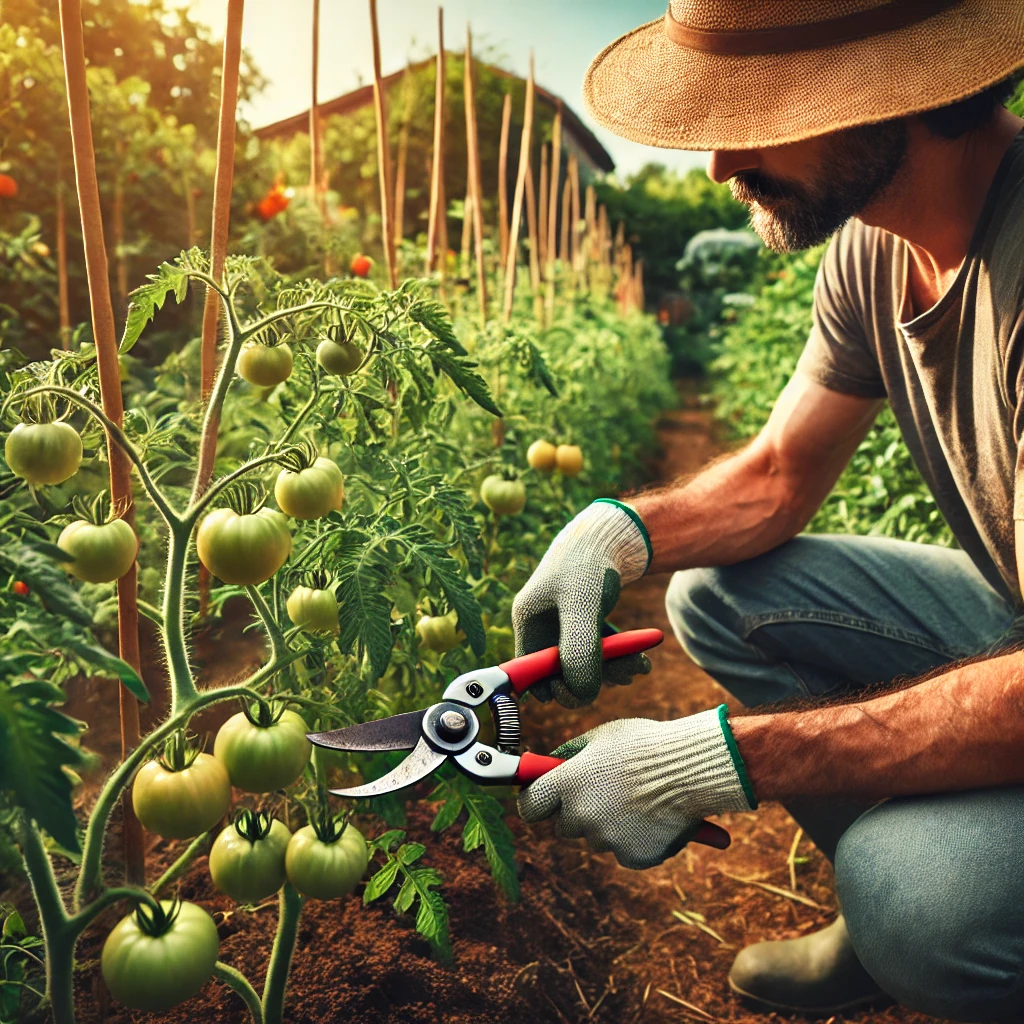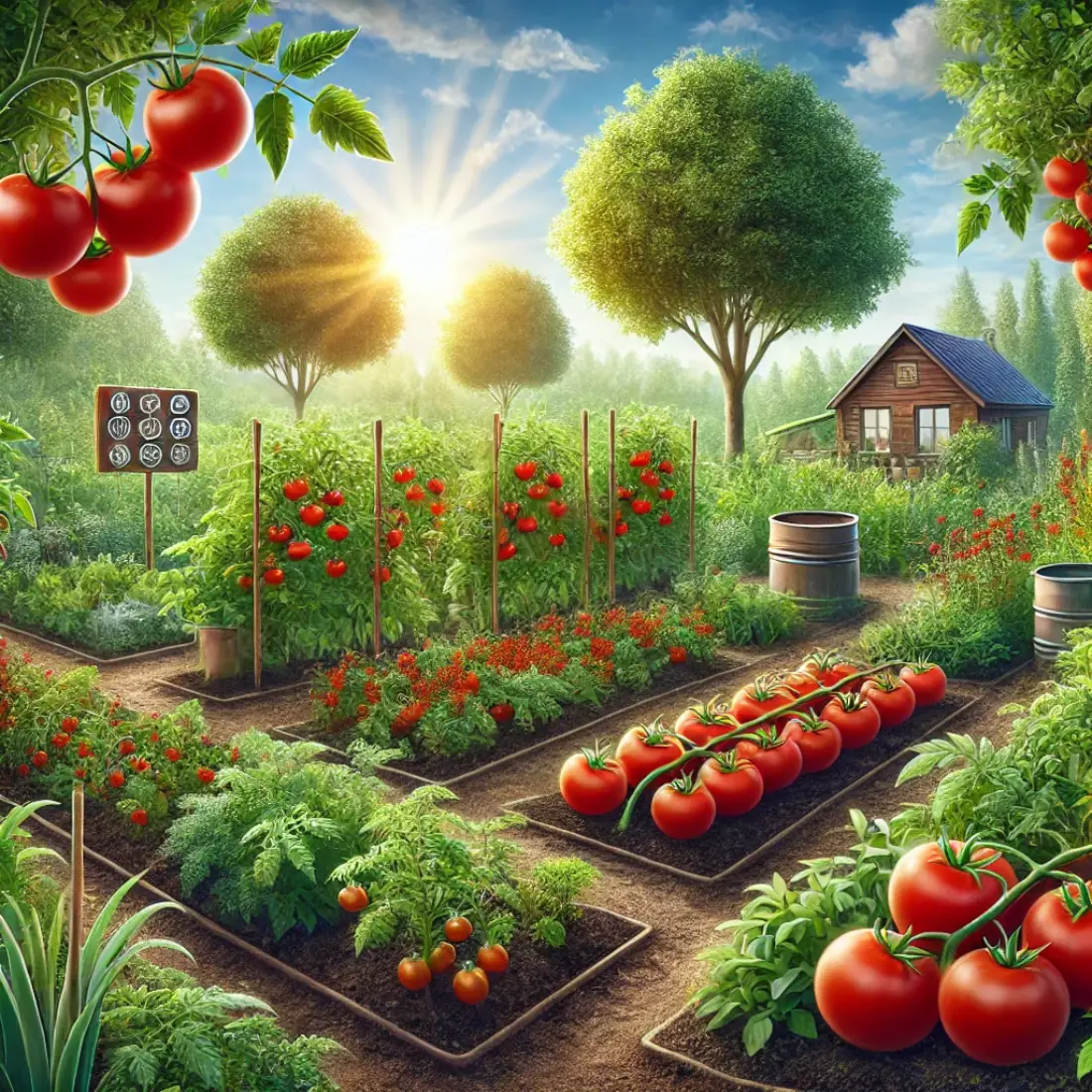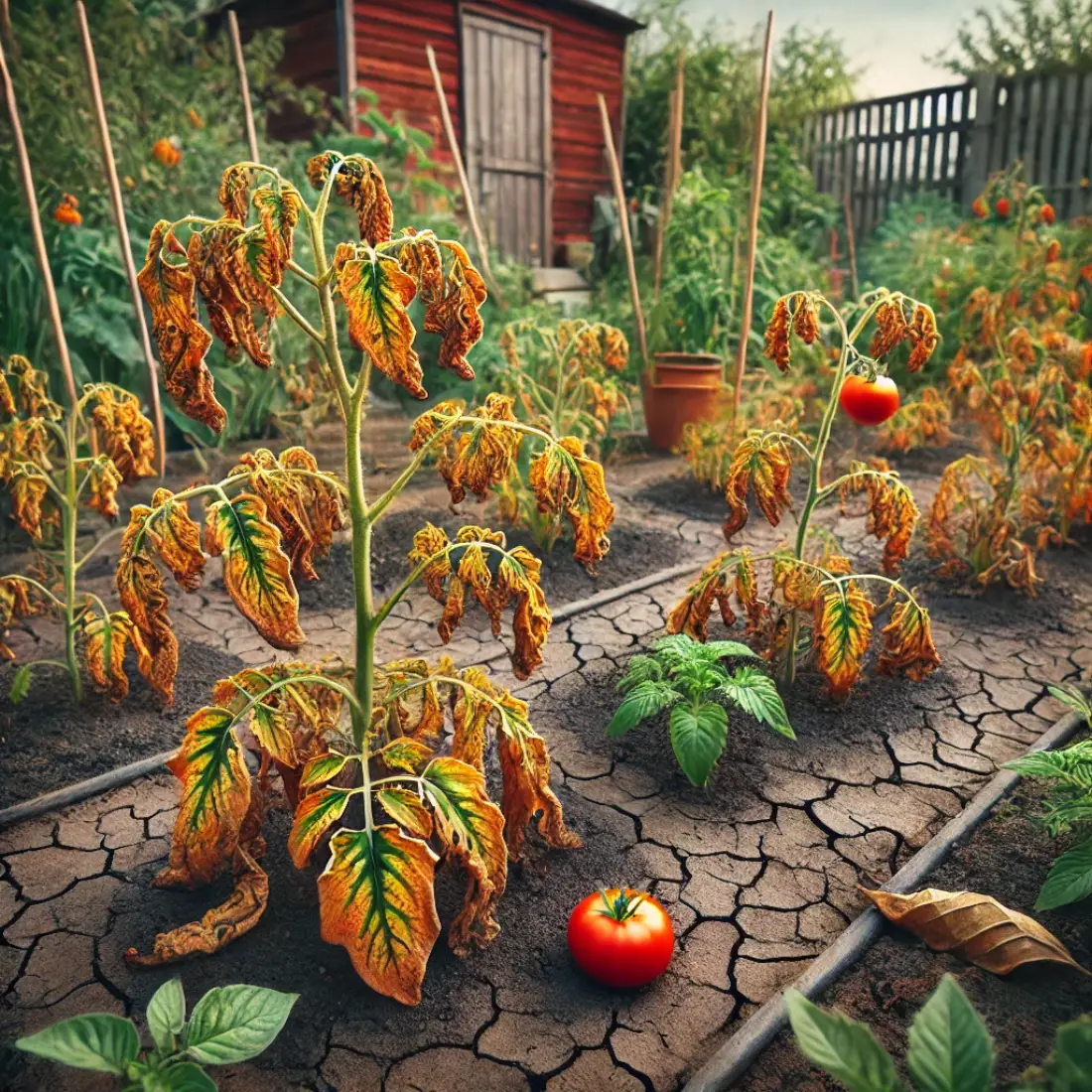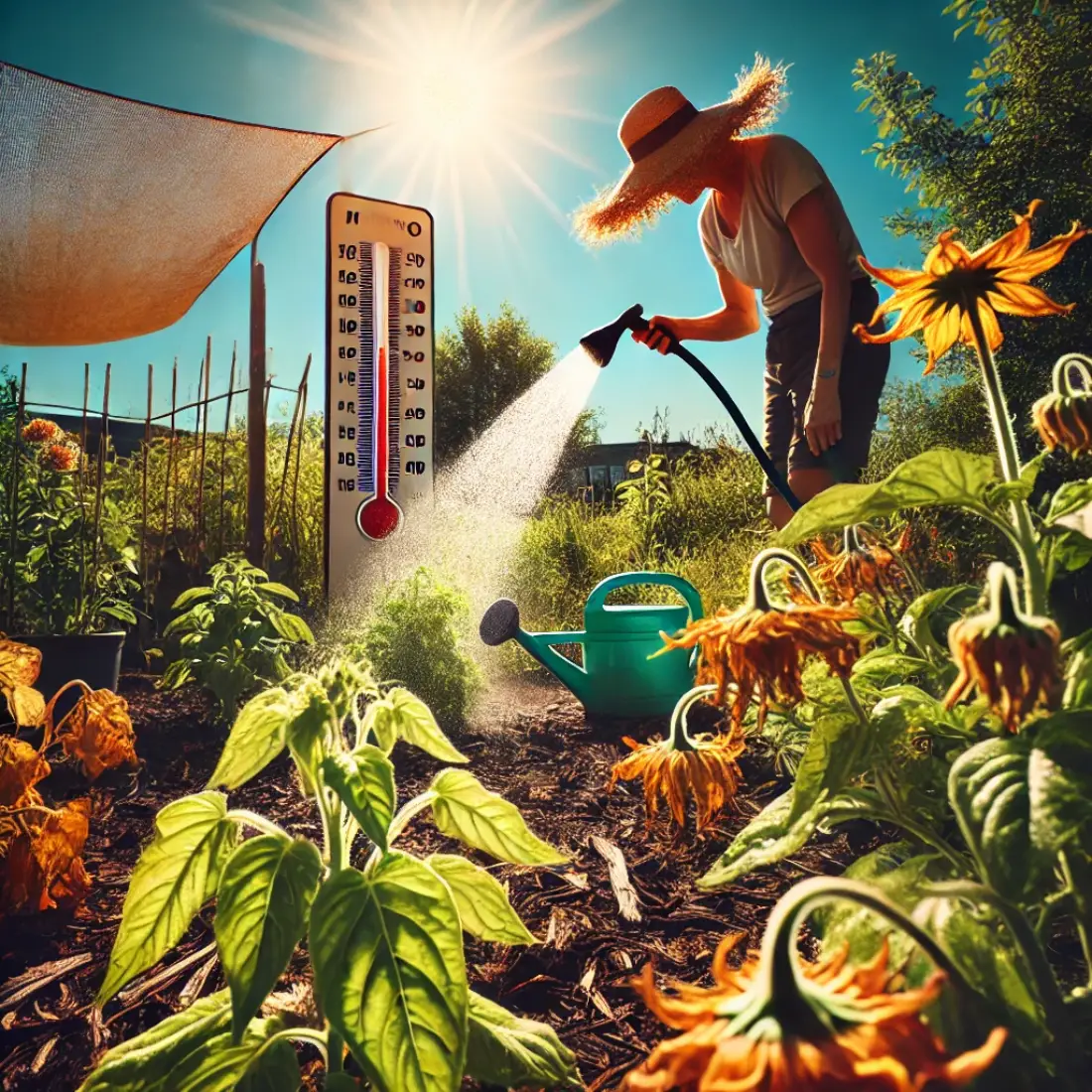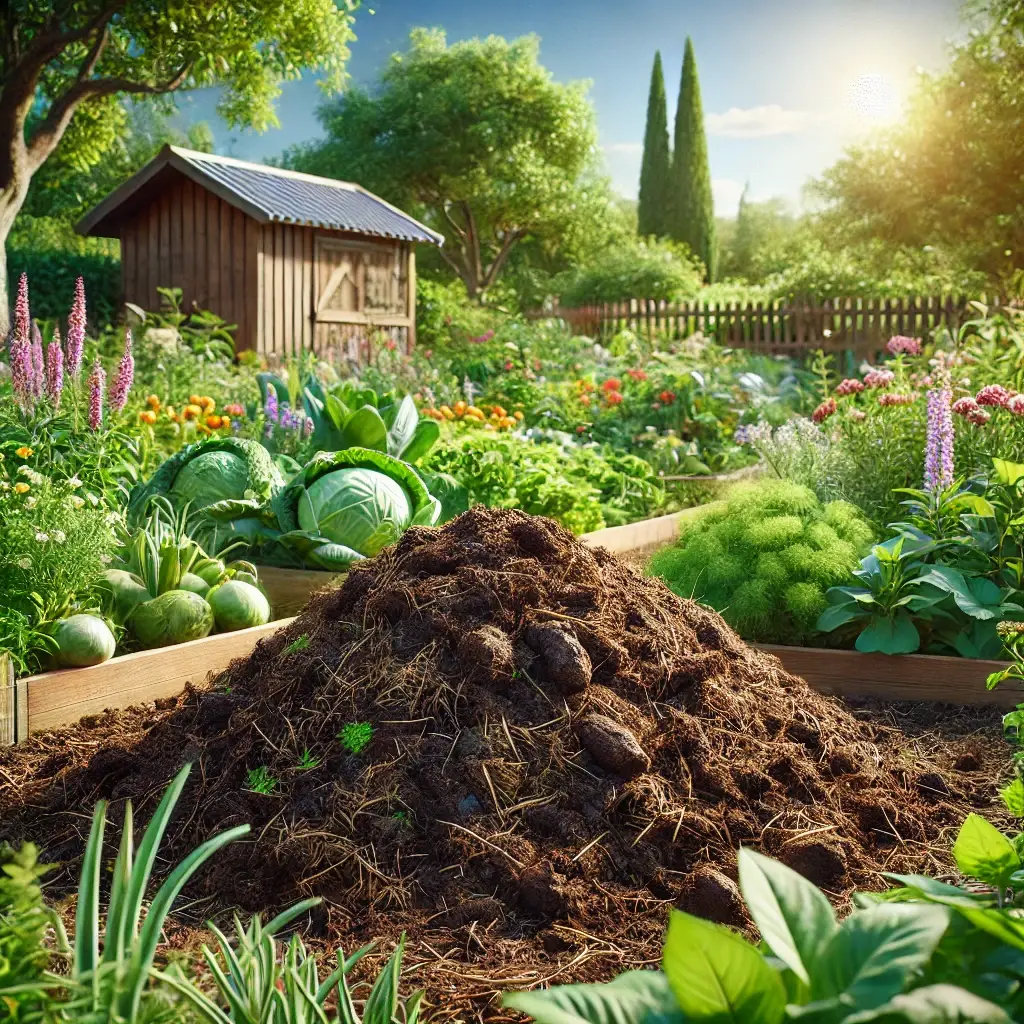Pruning tomato plants is a critical practice for gardeners seeking to maximize their organic yields. This simple yet effective technique involves the careful removal of certain parts of the plant to encourage healthier growth and more abundant fruit production.
By learning how to prune tomato plants properly, you can significantly enhance your garden’s productivity and ensure that your plants remain robust and disease-free throughout the growing season.
- Proper pruning of tomato plants can significantly increase yield.
- Pruning helps in disease prevention and ensures healthier plants.
- Different pruning techniques suit different types of tomato plants.
Types of Tomato Plants: Determinate vs. Indeterminate
Determinate varieties grow to a certain size and set all their fruit within a short period, making them ideal for gardeners who prefer a single, large harvest.
Indeterminate varieties, on the other hand, continue to grow and produce fruit throughout the season. Each type requires different pruning techniques to optimize yield and maintain plant health.
Determinate Tomato Plants
- Grow to a fixed size
- Set fruit all at once
- Minimal pruning required
Indeterminate Tomato Plants
- Continuous growth and fruit production
- Benefit from regular pruning
- More complex pruning techniques needed
Having the right tools is vital for effective and safe pruning. Pruning shears, disinfectants, and protective gloves are the basics you’ll need to get started. Ensuring that your tools are clean and sharp will help prevent the spread of disease and make the pruning process more efficient.
Best Time to Prune Tomato Plants
Timing is crucial when it comes to pruning tomato plants. For optimal results, start pruning early in the growing season, when the plants are still young and manageable. The best time to begin is when the first flowers appear, typically when the plant is about 12 to 18 inches tall.
At this stage, removing the early suckers will help the plant focus its energy on developing a strong central stem and healthy root system.Pruning should be done in the morning when the plants are dry, as this reduces the risk of spreading diseases.
Additionally, the plant’s wounds will have ample time to heal during the day, further minimizing disease risks. Regular pruning should continue throughout the growing season, especially for indeterminate varieties that keep producing new growth.
It’s also essential to monitor your plants regularly for any signs of disease or excessive growth that might require additional pruning. Consistent maintenance will ensure that your tomato plants remain healthy, productive, and capable of yielding a bountiful harvest.
Pruning Techniques for Tomato Plants
Effective pruning techniques are essential for maximizing the health and yield of your tomato plants. Here are some key methods:
Removing Suckers
Suckers are the small shoots that grow in the leaf axils, the space between the stem and a branch. Removing these suckers helps redirect the plant’s energy towards producing fruit rather than foliage. To remove a sucker, simply pinch it off with your fingers when it’s small (about 2-4 inches). For larger suckers, use pruning shears to avoid damaging the plant.
Trimming Lower Leaves
Removing the lower leaves of the plant, especially those that are yellowing or touching the ground, helps prevent disease and pests. These leaves are more prone to soil-borne diseases and can create a humid environment that fosters fungal growth. Trim the leaves up to the first fruit cluster to improve air circulation and sunlight penetration.
Topping the Plant
Topping, or cutting off the top of the plant, is a technique used late in the growing season to stop the plant from growing taller. This method helps the plant focus its energy on ripening the existing fruit rather than producing new growth. Use clean pruning shears to cut the main stem just above a set of leaves or a fruit cluster.
Pruning for Disease Prevention
Pruning tomato plants is not only essential for improving yields but also for preventing diseases. Proper pruning practices can significantly reduce the incidence of common tomato plant diseases and enhance the overall health of your garden.
Reducing Humidity
Pruning helps to reduce the humidity around the plant by increasing air circulation. Dense foliage creates a microenvironment where humidity levels can rise, promoting the growth of fungal diseases such as early blight and powdery mildew.
By removing excess leaves and branches, especially in the lower part of the plant, you allow for better airflow, which helps keep the foliage dry and less susceptible to infections.
Increasing Airflow
Enhanced airflow through the plant canopy is crucial for disease prevention. It not only reduces the risk of fungal diseases but also helps the leaves dry faster after rain or watering.
This is particularly important in humid climates where moisture can linger on leaves, creating a breeding ground for pathogens. Pruning to open up the plant structure allows for maximum air movement, keeping the plant healthier.
Limiting Contact with Soil
Pruning lower leaves that touch the ground is vital for preventing soil-borne diseases. Soil can harbor a variety of pathogens that can easily infect the plant through direct contact with leaves.
By removing these lower leaves, you minimize the risk of diseases such as septoria leaf spot and bacterial spot, which can devastate your tomato crop.
Regular pruning also allows you to inspect your plants more closely for any early signs of disease, enabling prompt action to prevent further spread. Consistent and strategic pruning, combined with other good gardening practices, will keep your tomato plants healthy and productive throughout the growing season.
Tomato Pruning Mistakes to Avoid
Pruning tomato plants is essential for a healthy and productive garden, but common mistakes can hinder your efforts. Here are some key errors to avoid:
Over-Pruning
Removing too many leaves and branches can stress the plant, reducing its ability to photosynthesize and produce fruit. Aim to maintain a balance, removing only unnecessary suckers and diseased or damaged leaves while preserving enough foliage to support healthy growth.
Under-Pruning
Neglecting to prune your tomato plants can lead to dense foliage, poor air circulation, and increased humidity. These conditions promote fungal diseases and reduce fruit production. Regular pruning ensures better airflow and light penetration, resulting in healthier plants and higher yields.
Pruning at the Wrong Time
Timing is crucial for effective pruning. Avoid pruning during wet or extremely hot conditions, as this can stress the plant and increase the risk of disease. The best time to prune is in the morning when the plants are dry, allowing wounds to heal during the day.
Using Dirty or Dull Tools
Dirty or dull pruning tools can spread diseases and cause damage to the plant. Always use clean, sharp tools to make precise cuts. Sterilize your tools with a bleach solution (one part bleach to ten parts water) before and after use to prevent the spread of pathogens.
Cutting Too Close to the Stem
When removing suckers or leaves, avoid cutting too close to the main stem, as this can create wounds that are more susceptible to disease. Leave a small stub (about a quarter of an inch) to promote faster healing and reduce the risk of infection.
Ignoring Lower Leaves
Failing to remove lower leaves that touch the ground increases the risk of soil-borne diseases. These leaves can come into contact with pathogens in the soil and spread them to the rest of the plant. Regularly trim the lower leaves to prevent disease and improve air circulation.
Inconsistent Pruning
Inconsistent pruning can lead to uneven growth and reduced yields. Make pruning a regular part of your gardening routine, inspecting your plants weekly and removing suckers and unnecessary foliage as needed.
FAQs on Tomato Plant Pruning
How often should I prune my tomato plants?
Prune your tomato plants every 1-2 weeks. Regular pruning helps manage the plant’s growth and ensures continuous air circulation and light penetration, which are vital for healthy, productive plants.
Can I prune my tomato plants too much?
Yes, over-pruning can stress the plant and reduce its ability to produce fruit. Aim to remove only unnecessary suckers and lower leaves while maintaining sufficient foliage for photosynthesis.
What should I do if my tomato plant shows signs of disease after pruning?
If your tomato plant shows signs of disease after pruning, remove the affected parts immediately. Ensure your pruning tools are disinfected before and after use to prevent the spread of disease. Consider applying an organic fungicide if the problem persists.
When is the best time of day to prune tomato plants?
The best time of day to prune tomato plants is in the morning when the plants are dry. This timing allows the wounds to heal during the day, reducing the risk of disease.
Should I prune determinate tomato plants?
Determinate tomato plants require minimal pruning. Focus on removing only the lower leaves that touch the ground and any damaged or diseased foliage. Over-pruning can reduce their overall yield.
How do I identify suckers on tomato plants?
Suckers are small shoots that grow in the leaf axils, the junction between the stem and a branch. They typically appear as small, new growth and should be removed when they are about 2-4 inches long.
Is it necessary to prune the top of tomato plants?
Topping tomato plants, or cutting off the top, is beneficial late in the growing season to stop upward growth and encourage the plant to focus on ripening existing fruit. This technique is particularly useful for indeterminate varieties.
What are the risks of not pruning tomato plants?
Not pruning tomato plants can lead to dense foliage, reduced air circulation, and higher humidity around the plant. These conditions increase the risk of fungal diseases and can result in lower fruit production and quality.
Can I use household disinfectants on pruning tools?
Yes, household disinfectants like bleach solutions (one part bleach to ten parts water) can be used to sterilize pruning tools. Ensure the tools are rinsed and dried thoroughly after disinfecting to prevent damage.
How can I prune my tomato plants to maximize sunlight exposure?
To maximize sunlight exposure, remove the lower leaves and suckers regularly. Ensure that the remaining foliage is spaced out to allow light to penetrate through the entire plant. Strategic pruning will help all parts of the plant receive adequate sunlight.

